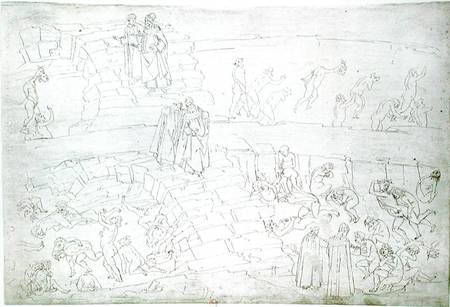


Flames shoot down from a dark cloud that hovers over them. At center, a man is in up to his waist as he holds his hands over his head. At right one woman walks in, ankle deep, but just beyond her, a pair of hands poking out of the muck are all that is visible of another figure. For example in the image pictured here, an illustration of canto seventeen, we see Dante’s reaction to a prophecy that he will be exiled from his hometown-as, in fact, he already had been at the time of his writing.Below in the foreground, various naked figures struggle to move through a pit filled with grey-brown muck. Principally featuring these two characters within a perfectly rounded circle, we see the unseeable through the gestures and expressions of these two figures. He deliberately chose not to illustrate the intangible elements that surround Dante and Beatrice, a choice that in fact furthers one’s sense of the journey’s ineffability. Botticelli’s approach in picturing the mysterious spheres of the heavens is especially memorable.

The horrors of the dark underworld are truly horrifying, and the wonders of the celestial realm, wonderful. Sandro Botticelli, Inferno, Canto XXXIV (detail), 1480s, silverpoint on parchment, completed in pen and ink (Staatliche Museen, Berlin)From the beasts of Hell-such as the now familiar three-headed Satan chewing sinners-to the journey through paradise, Botticelli proves himself a careful reader and a thoughtful illustrator. The link to this mosaic image is just one example of how the visual arts passed from Dante’s memory through his imagination and onto the pages of his epic poem. Satan has three mouths, and "In each of his mouths he was breaking a sinner/ with his teeth in the manner of a scutch, so that he made the three suffer at once" (translation by Durling and Martinez)-just like the image of Satan inside the Florence Baptistery.

For example, at the end of the Inferno, when Dante's fictional self reaches the deepest part of Hell and encounters "the emperor of the dolorous kingdom" (Satan), Dante’s description is strikingly specific. Quite a few correspondences can be discerned between certain descriptions in the Comedy and particular images within this baptistery-indeed, too many to be mere coincidence. There are many indications that Dante too was dazzled by the sight. The ceiling inside the baptistery is covered with mosaic images that still dazzle visitors today. The Florence Baptistery (illustrated above), which Dante fondly referred to in his Comedy as his "bel (beautiful) San Giovanni," is one such example, which the poet would have known well, even from the days of his youth. Incredible works of art and architecture filled the city well before Dante's birth in late medieval times. Florence was full of artistic marvels well before the Renaissance.


 0 kommentar(er)
0 kommentar(er)
